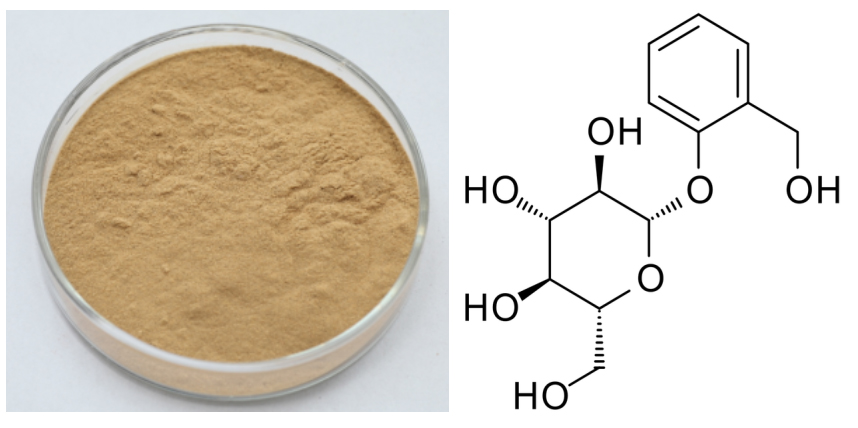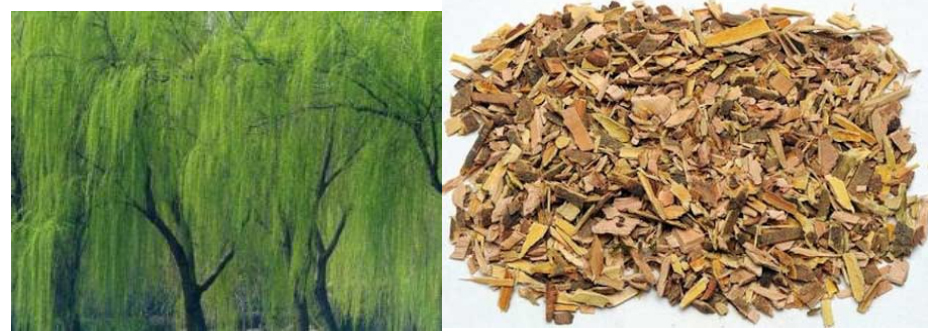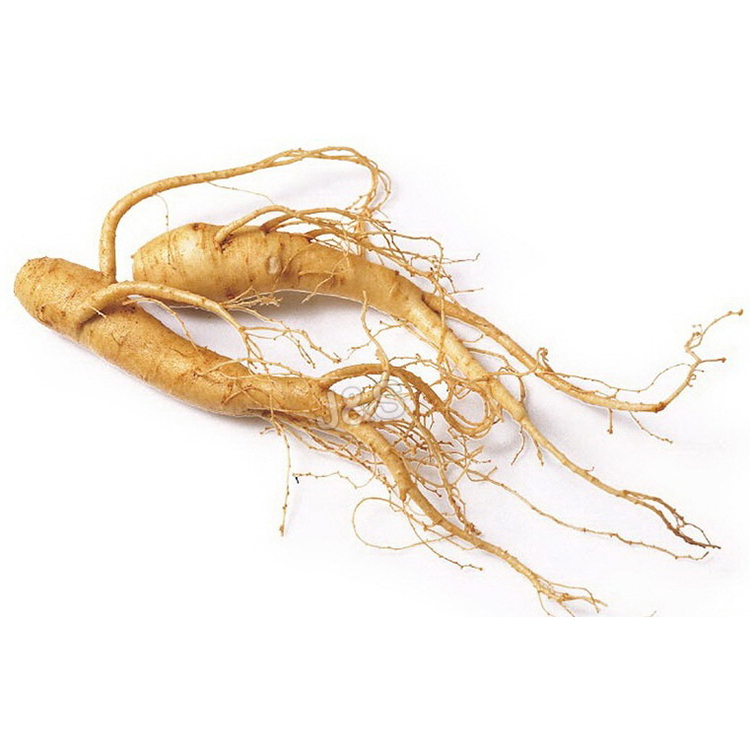China Factory for White Willow Bark Extract in Barcelona
China Factory for White Willow Bark Extract in Barcelona Detail:
[Latin Name] Salix alba L.
[Plant Source] from China
[Specifications] Salicin 15-98%
[Appearance] Yellow Brown to White powder
Plant Part Used: Bark
[Particle size] 80 Mesh
[Loss on drying] ≤5.0%
[Heavy Metal] ≤10PPM
[Storage] Store in cool & dry area, keep away from the direct light and heat.
[Shelf life] 24 Months
[Package] Packed in paper-drums and two plastic-bags inside.
[Net weight] 25kgs/drum
Brief Introduction
Salicin is a naturally occurring compound found in the bark of several species of trees, primarily North American in origin, that are from the willow, poplar, and aspen families. White willow, from whose Latin name, Salix alba, the term salicin is derived, is the most well known source of this compound, but it is found in a number of other trees, shrubs, and herbaceous plants as well being synthesized commercially. It is a member of the glucoside family of chemicals and is used as an analgesic and antipyretic. Salicin is used as a precursor for the synthesis of salicylic acid and acetylsalicylic acid, commonly known as aspirin.
A colorless, crystalline solid in its pure form, salicin has the chemical formula C13H18O7. Part of its chemical structure is equivalent to the sugar glucose, meaning it is classified as a glucoside. It is soluble, but not strongly so, in water and alcolhol. Salicin has a bitter taste and is a natural analgesic and antipyretic, or fever reducer. In large quantities, it can be toxic, and overdoses may lead to liver and kidney damage. In its raw form, it may be mildly irritating to skin, respiratory organs, and eyes.
Function
1. Salicin is used to ease pain and reduce inflammation.
2. Relieve acute and chronic pain, including headache, back and neck pain, muscle aches, and menstrual cramps; Control arthritis discomforts.
3. Relieve acute and chronic pain.
4. It has the same effect on the body as aspirin without any of the side effects.
5. It is an anti-inflammatory, a fever reducer, an analgesic, an anti-rheumatic, and an astringent. Specifically, it helps to relieve headaches.
Application
1.Anti-inflammatory, anti-rheumatic,
2.Reduce a fever,
3.Use as an analgesic and astringent,
4.Relieve headache,
5.Ease pain caused by rheumatism, arthritis, and carpal tunnel syndrome.
Product detail pictures:
Related Product Guide:
Our well-equipped facilities and great good quality regulate throughout all stages of manufacturing enables us to guarantee total buyer gratification for China Factory for White Willow Bark Extract in Barcelona , The product will supply to all over the world, such as: Guyana, Tajikistan, Spain, We have established long-term, stable and good business relationships with many manufacturers and wholesalers around the world. Currently, we are looking forward to even greater cooperation with overseas customers based on mutual benefits. Please feel free to contact us for more details.
Created by Ryan Scott Patton.
Watch the next lesson: https://www.khanacademy.org/test-prep/mcat/chemical-processes/amino-acids-peptides-proteins-5d/v/central-dogma-of-molecular-biology-2?utm_source=YT&utm_medium=Desc&utm_campaign=mcat
Missed the previous lesson? https://www.khanacademy.org/test-prep/mcat/chemical-processes/nucleic-acids-lipids-and-carbohydrates/v/keto-enol-tautomerization?utm_source=YT&utm_medium=Desc&utm_campaign=mcat
MCAT on Khan Academy: Go ahead and practice some passage-based questions!
About Khan Academy: Khan Academy offers practice exercises, instructional videos, and a personalized learning dashboard that empower learners to study at their own pace in and outside of the classroom. We tackle math, science, computer programming, history, art history, economics, and more. Our math missions guide learners from kindergarten to calculus using state-of-the-art, adaptive technology that identifies strengths and learning gaps. We’ve also partnered with institutions like NASA, The Museum of Modern Art, The California Academy of Sciences, and MIT to offer specialized content.
For free. For everyone. Forever. #YouCanLearnAnything
Subscribe to Khan Academy’s MCAT channel: https://www.youtube.com/channel/UCDkK5wqSuwDlJ3_nl3rgdiQ?sub_confirmation=1
Subscribe to Khan Academy: https://www.youtube.com/subscription_center?add_user=khanacademy
Professor Maureen McCann, Director of the Energy Center at Purdue University, addresses “A Roadmap for Selective Deconstruction of Lignocellulosic Biomass to Advanced Biofuels and Useful Co-Products” on February 11, 2013 as part of the Andlinger Center’s 2012-2013 Highlight Seminar Series.
ABSTRACT
Second-generation biofuels will be derived from lignocellulosic biomass using biological catalysis to use the carbon in plant cell wall polysaccharides for ethanol or other biofuels. However, this scenario is both carbon- and energy-inefficient. The major components of biomass are cellulose, hemicellulose and lignin. Biological conversion routes utilize only the polysaccharide moiety of the wall, and the presence of lignin interferes with the access of hydrolytic enzymes to the polysaccharides. Living micro-organisms, required to ferment released sugars to biofuels, utilize some sugars in their own growth and co-produce carbon dioxide. In contrast, chemical catalysis has the potential to transform biomass components directly to alkanes, aromatics, and other useful molecules with improved efficiencies. The Center for Direct Catalytic Conversion of Biomass to Biofuels (C3Bio) is a DOE-funded Energy Frontier Research Center, comprising an interdisciplinary team of plant biologists, chemists and chemical engineers. We are developing catalytic processes to enable the extraction, fractionation, and depolymerization of cellulose and hemicellulose coupled to catalytic transformation of hexoses and pentoses into hydrocarbons. Additional catalysts may cleave the ether bonds of lignin to release useful aromatic co-products or that may oxidize lignols to quinones. In a parallel approach, fast-hydropyrolysis is a relatively simple and scalable thermal conversion process. Our understanding of biomass-catalyst interactions require novel imaging and analysis platforms, such as mass spectrometry to analyze potentially complex mixtures of reaction products and transmission electron tomography to image the effects of applying catalysts to biomass and to provide data for computational modeling. By integrating biology, chemistry and chemical engineering, our data indicate how we might modify cell wall composition, or incorporate Trojan horse catalysts, to tailor biomass for physical and chemical conversion processes. We envision a road forward for directed construction and selective deconstruction of plant biomass feedstock.
BIOGRAPHY
Maureen McCann is the Director of Purdue’s Energy Center, part of the Global Sustainability Initiative in Discovery Park. She obtained her undergraduate degree in Natural Sciences from the University of Cambridge, UK, in 1987, and then a PhD in Botany at the John Innes Centre, Norwich UK, a government-funded research institute for plant and microbial sciences. She stayed at the John Innes Centre for a post-doctoral, partly funded by Unilever, and then as a project leader with her own group from 1995, funded by The Royal Society. In January 2003, she moved to Purdue University as an Associate Professor, and she is currently a Professor in the Department of Biological Sciences.
The goal of her research is to understand how the molecular machinery of the plant cell wall contributes to cell growth and specialization, and thus to the final stature and form of plants. Plant cell walls are the source of lignocellulosic biomass, an untapped and sustainable resource for biofuels production with the potential to reduce oil dependence, improve national security, and boost rural economies. She is also the Director of the Center for Direct Catalytic Conversion of Biomass to Biofuels (C3Bio), an interdisciplinary team of biologists, chemists and chemical engineers in an Energy Frontier Research Center funded by the US Department of Energy’s Office of Science.
The manufacturer gave us a big discount under the premise of ensuring the quality of products, thank you very much, we will select this company again.







